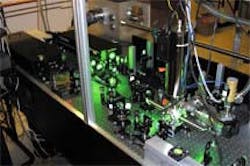
One sign that a technology is maturing is the evolution of large, awkward prototypes into compact and easy-to-use devices. This sort of change is happening in the area of high-average-power ultrafast lasers. Existing sources of this type typically take up two or more optical tables and require several stages of amplification. Researchers at the University of Colorado (Boulder, CO) have built a compact single-stage ultrafast laser system that operates at a repetition rate of 1 to 10 kHz and emits up to 13 W of average power in 24-fs pulses. This system takes up an area of only 1.5 m2 on a single optical table.
The system contains a Ti:sapphire oscillator that generates 11-fs pulses and relies on chirped-pulse amplification. The single-stage 12-pass amplifier is cooled to 77 K to get rid of thermal lensing even at high power. The lack of thermal lensing effects results in a conversion efficiency of 26% and the ability to run at widely varying repetition rates and average powers. The stainless-steel cooling cell has a Brewster-angle window for the entry and exit beams; liquid nitrogen is pumped into the cell to cool the crystal. Liquid nitrogen is consumed at 1 L/h; the researchers aim to replace the setup with a closed-loop liquid-nitrogen cooling system.
For amplification, 11-fs pulses are stretched to 206 ps; gain narrowing in the amplifier reduces this duration to 126 ps. The pulses are injected into the amplifier, which is pumped with a diode-pumped frequency-doubled Nd:YAG laser. For 8 to 8.6 mJ of pump energy at repetition rates of 1 to 5 kHz, the setup produces 1.4 mJ of compressed output. For higher repetition rates, the output-pulse energy drops; for example, at the maximum rate of 10 kHz, the output-pulse energy is 0.6 mJ. This drop is partially due to a drop in pump-beam energy at high rates. The maximum average power of 13 W is reached at 7 kHz. The first applications for this laser will be extreme-ultraviolet (EUV) generation and imaging, vacuum-ultraviolet and EUV holography, and EUV nonlinear optics, according to Backus Sterling, one of the researchers.
About the Author
John Wallace
Senior Technical Editor (1998-2022)
John Wallace was with Laser Focus World for nearly 25 years, retiring in late June 2022. He obtained a bachelor's degree in mechanical engineering and physics at Rutgers University and a master's in optical engineering at the University of Rochester. Before becoming an editor, John worked as an engineer at RCA, Exxon, Eastman Kodak, and GCA Corporation.
